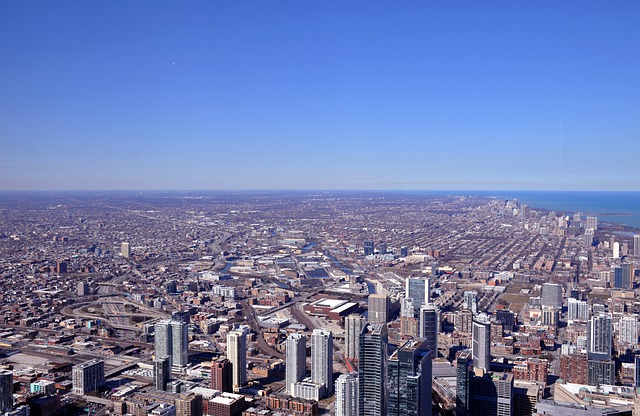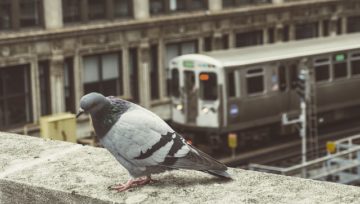
Soundtrack in my head: Bonnie Dobson, “Rainy Windows”
I moved to Madison 3 1/2 years ago after spending 30 of my years in the Chicago area. Since moving up north I’ve been to my parent’s house in the Chicago suburb of La Grange a number of times. But since January 2003, I’ve rarely ventured into the city itself, much less the Ravenswood neighborhood where I spent my last six years in the city.
When I lived in Chicago, I logged many miles on the Kennedy Expressway, which is the stretch of Interstate 90 between O’Hare Airport and downtown Chicago. I could drive as well as any Chicagoan—passing on the right at stoplights, weaving across four lanes at once to avoid getting diverted to Milwaukee, etc. But when I ventured onto the Kennedy for the first time after six months of living among relatively polite Madisonians, I found myself gripping the steering wheel saying to myself, “These…people…are…crazy…these…people…are…crazy!” Funny what civilized behavior does to you.
So I didn’t know what to expect when my sister and her boyfriend drove me to their new apartment in the Ravenswood Manor neighborhood, just a few blocks from my last apartment in Chicago. Would I forget I ever left? Or would I be like a Wisconsin deer staring into headlights on the Dan Ryan Expressway?
At first, I thought it would be the former. My sister drove me up Lake Shore Drive, and got off at Lawrence Avenue, which is where I got off to get to my last apartment in Chicago. I looked around and thought to myself, this is familiar, this is familiar, and I began to feel like I was transported back to 2001. There weren’t too many changes in the neighborhoods along Lawrence Avenue, except a new Border’s Bookstore at Broadway.
But when my sister turned into the alleyway behind her new apartment building, it seemed rather strange—it seemed like the garages in the alley and the buildings behind them were packed together so tightly that it made me a bit nervous. maybe slightly claustrophobic. Which is funny because about seven years ago some friends from Kansas visited me in Chicago, and they had the same reaction to my neighborhood. We had to move some things from my father’s house to her third-floor apartment, which meant climbing some twisty, narrow stairs, and I was a little paranoid that I might plunge forty feet to the cement below. My room here in my co-op house is also a third floor, but in most Chicago apartments, third floor really means fourth floor. I found myself very winded after climbing those stairs. My allergies had gone somewhat haywire while helping my father preparing for moving—the cat hair in the place ganged up with moving dust to assault my immune system. So maybe I was reacting to that, or maybe it was increased pollution in the area, or both. I do know that after moving to Madison, the number of migraines I’ve gotten has dropped significantly, perhaps due to a difference in the air quality.
I think that Madison on the whole has nicer and more interesting single-family homes than the Chicago area does, but for apartments, nothing beats a nice 1920s vintage brownstone. Such buildings are almost non-existent in Madison, but they’re everywhere in Chicago. I lived in several. The one my sister and her boyfriend have is very nice, and laid out similarly to one I used to live in. A sunroom off the living room, then a long hallway flanked by bedrooms and the bathroom, and then opening up to a dining room, a kitchen, and an enclosed back porch that people tend to store things in. Hardwood floors, beautiful bathroom tile, free radiator heat. For about two seconds, I thought, okay, I’m dropping everything and moving back to Chicago.
The next day, I decided to do some exploring of the old city. I walked down Lawrence Avenue, then took a bus to Uptown to exchange a gift at the Border’s Bookstore and visit the place out of morbid curiosity. For most of my life, I’d known Uptown to be an interesting but somewhat scary place–where I’d see great music at the Riviera or Green Mill, and then walk quickly back to the el stop and avoid eye contact with strangers. Despite the Border’s (and a rumored Starbucks nearby?) the neighborhood had not changed much. It still had its share of litter blowing down the. And when I boarded the Red Line at Wilson Avenue, there was—yup, just like I remembered—the stale urine smell permeating the walls of the station.

I’d read on the bus that the CTA had added a new el train line. The Pink Line joined the other venerable colors of Red, Purple, Yellow, Brown, Blue, Green and Orange. It actually wasn’t new—it was actually the south branch of the Blue Line that goes through some of the roughest neighborhoods on Chicago’s west side before ending in the suburb of Cicero. I thought pink was a rather funny color to choose for that line and wondered whether the color choice was part of some sinister plot to perform some psy-ops social engineering experiments on the good citizens of those neighborhoods. In any case, I boarded the line because it would take me where I wanted to go—18th Street in the Pilsen neighborhood. It was an interesting ride because it cut west along the Green Line (the old Lake Street el tracks, which I took many times from my hometown of Oak Park down to the Loop and back) and then cut south along a set of previous seldom-used tracks that linked the Green Line with the Blue Line and then went under some hospital buildings. I’d seen those tracks for years and had wondered what it would be like to ride on them.
I’d always been drawn to Pilsen for reasons I could never quite explain. I never lived there but had harbored fantasies of doing so. It’s a mostly Mexican neighborhood that has had some gentrification in recent years. A number of artists have been attracted to the neighborhood. I walked east down 18th Street from the el station down to Halsted Street, and it appears to have changed little, though I did notice that the Nuevo Leon Restaurant, which serves inexpensive but delicious Mexican food, appears to have gotten a remarkably colorful facelift.
Then I walked north on Halsted towards the University of Illinois at Chicago and was taken aback by the changes there in the Maxwell Street neighborhood. Maxwell Street is so famous as port of entry for immigrants and a market for cheap stuff that even Madison has its own “Maxwell Street Days” with the shops of our State Street (not to be confused with the Chicago street by the same name.) I knew that there had been a lot of controversy over the redevelopment of the Maxwell Street area, but I was not prepared for what I would see between 16th Street and Roosevelt Road—the largest alien landing I’d witnessed since the mother ship Ikea descended on Schaumburg. Except rather than introducing us to Swedish meatballs and interesting albeit awkward-sounding names like Klunsa, Traktor, Jerker, and Lycklig, I instead found “University Village—Chicago’s newest neighborhood” with names like Whole Foods, Starbucks, Jamba Juice and Cold Stone Creamery. I saw rows and rows of identical modern red-brick two-story apartment and condo buildings that looked marginally nicer than college dormitories, going for miles up and down streets that were renamed University Lane and College Court. I looked around me and I thought “hmm…could be Chicago, could be a tourist trap in New Jersey, or it could be Naperville in the throes of a New Urbanism kick.”
Us Chicago natives are weaned from an early age to become architecture snobs, with aesthetic critiques of the playground equipment not uncommon by the age of five–so my words should be taken with some grains of salt. But the bottom line is that I was saddened to see the old Maxwell Street neighborhood go. Certainly it needed sprucing up and cleaning up, but I think it could have done without losing the essence of what the neighborhood was about. What had landed here was something completely different. The city fathers still seem to feel that in order to make a neighborhood nicer and more attractive to some people, it is necessary to push other people–the ones who live and work there–out of the way. That’s one reason I left Chicago.
Overall, I felt nostalgic about my old home but didn’t miss it one bit. Walking down Lawrence Avenue, and many other streets in the city, it seemed like everything was covered with a thin film of grime—something I’d noticed but never really paid attention to when I lived there. I think the air was noticeably sootier. And the smell of urine permeated many corners of the city. I couldn’t sit in the station house of the Metra station near Western & Grand Avenue because of the smell of urine.
While I remember the rush-hour traffic jams on Chicago’s expressways, I’d forgotten how difficult it was to get from point A to B even on the main streets of the city. As my father drove me downtown from La Grange, we got caught in Taste of Chicago traffic, and I was late for the hourly Metra train to the Western suburbs because I made the mistake of taking literally the bus schedules, and even the ten-minute cushion I allowed for was not enough due to a construction backup at Western and Belmont Avenue that took forever to get through. I’ve become spoiled by the 10-25 minute commutes here in Madison.
Once upon a time, about seven years ago, I boasted to a roomful of people that the day I left Chicago would be the day that it crumbled at my heels as I was fleeing the city. I was feeling self-righteous about the fact that so many people in the room chose to leave the city for the suburbs and the exurbs. Well, Chicago still occupies that corner of Lake Michigan, but I no longer do.
The soundtrack in my head that I listed on top of this posting is a haunting but beautiful song by Bonnie Dobson, another ex-Chicagoan. I was taping a segment of WFMT’s “Midnight Special,” a folk/eclectic radio show, which, on that day was featuring a lot of Chicago-themed music, including the famous Aliotta-Haynes-Jeremiah hit “Lake Shore Drive,” Steve Goodman’s “Lincoln Park Pirates,” and a politically incorrect comedy sketch which concocted funny accents for different Chicago street names. But I don’t think Chicago’s tourism bureau would highlight “Rainy Windows.” It’s wistful, yet very clear as to why she would want to leave Chicago, and while she wrote it over thirty years before I ultimately left Chicago myself, my reasons for leaving were quite similar. “Chicago seen through rainy windows, you know why I had to go…”

I agree that Maxwell Street will be missed. Aside from its rich ambiance and history, the street was the mother lode of used hubcaps. For generations, every wheel cover that went missing in all of Chicago inevitably gravitated to a yard on Maxwell Street. Whenever your car lost one, replacing it was a simple matter of browsing the yard, selecting the hubcap that matched your car (which may even have been the one you lost)and paying the man a sawbuck or two. With Maxwell street gone, where do all those missing hubcaps go to reappear?